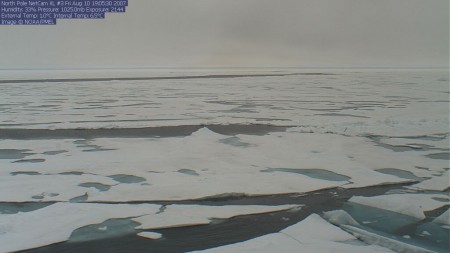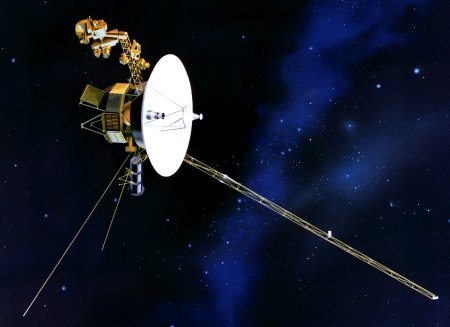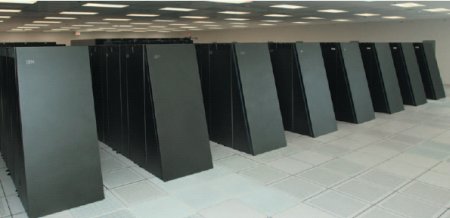Seven Wonders of the IT World
CIO magazine has published an interesting list of the seven wonders of the IT world . This list was compiled based on user voting results and it includes the most impressive achievements of computer equipment.
www.arctic.noaa.gov/gallery_np.html

The US National Oceanic and Meteorological Administration has installed a computer in close proximity to the North Pole, north of Norway. On a metal platform from a drifting ice in the Arctic Ocean, he sends photos of 2,048 × 1,536 pixels every 14 days along with his current coordinates, which change all the time. The battery floats below the surface of the ice and somehow recharges the computer continuously. Webcam model: StarDot Technologies NetCam XL.
')
www.nasa.gov/mission_pages/voyager/index.html

The ship was launched thirty years ago and long ago flew out of the solar system, daily moving away from it by another 1.6 million km. To date, the distance to the Sun is more than 15.44 terameters. Communication with the Earth is maintained through the Deep Space Network orbital computer network: a system of antennas in earth orbit.
The main data center Google is located in Oregon, 128 km from Portland. Electricity comes from a nearby hydroelectric station, and to cool the servers, we had to build two four-story water towers. The number of technicians-engineers is kept secret: from 100 to 200 people. The total number of servers is also unknown (Google has half a million servers in 25 data centers; they store 25 PB of data). The building is strictly guarded, for it is set the highest level of secrecy. Over the entire history, only two local journalists managed to get into it, they wrote this article .
www.eu-egee.org
Launched in September 2006 and accessible to all scientists in the world, this computer network unites 36,000 processors and 5 PB of disk space (240 supercomputers and computer networks in 45 countries are combined). The network helps carry out resource-intensive experiments in physics, chemistry, and others that require massive computations. For example, this is where the data from the CERN Large Hadron Collider accelerator is processed. Besides him, 98,000 tasks per day are counted per day, more than a million per month.
domino.research.ibm.com/comm/research_projects.nsf/pages/bluegene.index.html

The distributed computing system on 65,536 dual-processor computers occupies an area of 232 m 2 in the Livermore Laboratory. Lawrence (Lawrence Livermore National Laboratory) in California. Used to calculate scientific experiments, such as simulating a nuclear explosion. The giant cluster with a capacity of 280.6 teraflops consumes 1.5 megawatts of electricity. According to rough estimates, the cost of equipment is close to $ 100 million.
To estimate the performance of IBM BlueGene / L, one can say this: every person on the planet, including infants, must perform 60,000 operations per second so that the entire population of the Earth compares the speed of calculations with this one supercomputer.
IBM has already announced the next generation Blue Gene / P supercomputer, three times more powerful.
www.oqo.com

The miniature handheld computer contains a 1.5 GHz processor, a 30 or 60 GB hard drive, up to 1 GB of RAM, Wi-Fi and Bluetooth interfaces. A full keyboard with 57 buttons, mouse buttons, a programmable wheel, a digital stylus. The battery lasts for three hours. The cost of the device is one and a half thousand dollars. However, do not rush to spend money. Surely in the very near future there will be more productive and miniature gadgets.
Created in 1991 by the Finnish soldier Linus Torvalds, the Linux operating system really threatens the hegemony of Windows, especially in the corporate market.
The Linux kernel contains 8.2 million lines of code, and about 85.63 lines (+ 10% per year) are added there every hour. The number of noted developers in the latest release was 3200 people. A new release is recently released every 2.6 months.
1. Computer closest to the North Pole: Webcam # 1
www.arctic.noaa.gov/gallery_np.html

The US National Oceanic and Meteorological Administration has installed a computer in close proximity to the North Pole, north of Norway. On a metal platform from a drifting ice in the Arctic Ocean, he sends photos of 2,048 × 1,536 pixels every 14 days along with his current coordinates, which change all the time. The battery floats below the surface of the ice and somehow recharges the computer continuously. Webcam model: StarDot Technologies NetCam XL.
')
2. The computer farthest from the Earth: the ship Voyager 1
www.nasa.gov/mission_pages/voyager/index.html

The ship was launched thirty years ago and long ago flew out of the solar system, daily moving away from it by another 1.6 million km. To date, the distance to the Sun is more than 15.44 terameters. Communication with the Earth is maintained through the Deep Space Network orbital computer network: a system of antennas in earth orbit.
3. The most intriguing data center: Google
The main data center Google is located in Oregon, 128 km from Portland. Electricity comes from a nearby hydroelectric station, and to cool the servers, we had to build two four-story water towers. The number of technicians-engineers is kept secret: from 100 to 200 people. The total number of servers is also unknown (Google has half a million servers in 25 data centers; they store 25 PB of data). The building is strictly guarded, for it is set the highest level of secrecy. Over the entire history, only two local journalists managed to get into it, they wrote this article .
4. The world's largest scientific project of distributed computing: E-sciencE II
www.eu-egee.org
Launched in September 2006 and accessible to all scientists in the world, this computer network unites 36,000 processors and 5 PB of disk space (240 supercomputers and computer networks in 45 countries are combined). The network helps carry out resource-intensive experiments in physics, chemistry, and others that require massive computations. For example, this is where the data from the CERN Large Hadron Collider accelerator is processed. Besides him, 98,000 tasks per day are counted per day, more than a million per month.
5. The most powerful supercomputer: IBM BlueGene / L
domino.research.ibm.com/comm/research_projects.nsf/pages/bluegene.index.html

The distributed computing system on 65,536 dual-processor computers occupies an area of 232 m 2 in the Livermore Laboratory. Lawrence (Lawrence Livermore National Laboratory) in California. Used to calculate scientific experiments, such as simulating a nuclear explosion. The giant cluster with a capacity of 280.6 teraflops consumes 1.5 megawatts of electricity. According to rough estimates, the cost of equipment is close to $ 100 million.
To estimate the performance of IBM BlueGene / L, one can say this: every person on the planet, including infants, must perform 60,000 operations per second so that the entire population of the Earth compares the speed of calculations with this one supercomputer.
IBM has already announced the next generation Blue Gene / P supercomputer, three times more powerful.
6. The smallest PC on Windows Vista: OQO Model 02
www.oqo.com

The miniature handheld computer contains a 1.5 GHz processor, a 30 or 60 GB hard drive, up to 1 GB of RAM, Wi-Fi and Bluetooth interfaces. A full keyboard with 57 buttons, mouse buttons, a programmable wheel, a digital stylus. The battery lasts for three hours. The cost of the device is one and a half thousand dollars. However, do not rush to spend money. Surely in the very near future there will be more productive and miniature gadgets.
7. The most powerful influence on corporate software: Linux kernel
Created in 1991 by the Finnish soldier Linus Torvalds, the Linux operating system really threatens the hegemony of Windows, especially in the corporate market.
The Linux kernel contains 8.2 million lines of code, and about 85.63 lines (+ 10% per year) are added there every hour. The number of noted developers in the latest release was 3200 people. A new release is recently released every 2.6 months.
Source: https://habr.com/ru/post/31246/
All Articles